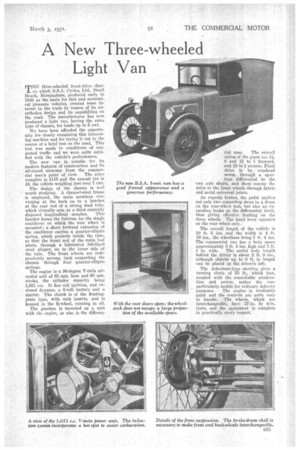A New Three-wheeled Light Van
Page 53

If you've noticed an error in this article please click here to report it so we can fix it.
rilHE three-wheeled front-drive chas sis which B.S.A. Cycles, Ltd., Small Heath, Birmingham, produced early in 1930 as the basis for fast and economical pleasure vehicles, created some interest in the trade by reason of its unorthodox design and its capabilities on the road. The manufacturer has now produced a light van, having the sams type of chassis, for loads up to 5 cwt.
We have been afforded the opportunity for closely examining this interesting machine and for trying it out in the course of a brief test on the road. This test was made in conditions of congested traffic and we were quite satisfied with the vehicle's performance.
The new van is notable for its modern features of construction and its all-round economy from the commer cial user's point of view. The price complete is £110 and the annual tax is £4, the vehicle weighing just over 7 cwt.
The design of the chassis is well worth studying. A channel-steel frame is employed, the main members converging at the back on to a bracket at the rear end of a strong steel tube, which virtually acts as a third centrally
disposed longitudinal member. This bracket forms the fulcrum for the siogle cantilever on which the rear wheel is mounted ; a short forward extension of the cantilever carries a quarter-elliptic spring, which projects inside the tube, so that the front end of the main leaf abuts, through a lubricated felt-lined steel slipper, on to the inner side of the tube. The front wheels are independently sprung, each supporting the chassis through four quarter-elliptic springs.
The engine is a 90-degree V-twin aircooled unit of 85 mm. bore and 90 ram. stroke, the cylinder capacity being 1,021 c.c. It has coil ignition, and enclosed dynamo, a 6-volt battery and a starter. The clutch is of the floatingplate type, with cork inserts, and is housed in the flywheel, running in oil.
The gearbox is mounted as a unit with the engine, as also is the differen tial ease. The overall
ratios of the gears are 5, 8 and 15 to 1 forward, and 18 to 1 reverse. Final drive is by overhead worm, through a spurtype differential to they two axle shafts, and these convey the drive to the front wheels through fabric and metal universal joints.
As regards brakes, the pedal applies not only two expanding shoes in a drum on the rear-wheel hub, but also an expanding brake on the differential itself, thus giving effective braking on the three wheels. The hand lever operates on the rear wheel only..
The overall length of the vehicle is 10 ft. .6 ins. and the width is 4 ft. 10 ins., the wheelbase being 7 ft. 4 ins. The commercial van has a body space approximately 3 ft. 4 ins, high and 3 ft.
1 in. wide. The useful body length behind the driver is about 2 ft. 9 ins.,. although objects up to 6 ft. in length can be placed at the driver's left.
The Ackerman-type steering, gives a turning circle of 35 ft., which fact, coupled with the remarkable acceleration and power, makes the vanparticularly mobile for ordinary delivery
purposes. The engine is creditably quiet and the controls are quite easy to handle. The wheels, which are interchangeable, have 27-in. by 4-in. tyres, and the equipment is complete in practically every respect.




































































































